
My Heart Is Calling You is the 1934 French version of a German musical film directed by Carmine Gallone and Serge Véber, written by Ernst Marischka, produced by Arnold Pressburger. The film stars Jan Kiepura, Danielle Darrieux and Lucien Baroux. The music score is by Robert Stolz.
City of Song, also known as Farewell to Love, is a 1931 British/German romance film directed by Carmine Gallone and starring Jan Kiepura, Betty Stockfeld and Hugh Wakefield. It was shot at Wembley Studios. The film's sets were designed by the art directors Oscar Friedrich Werndorff and J. Elder Wills. A German-language version was released in 1930 under the title The Singing City.
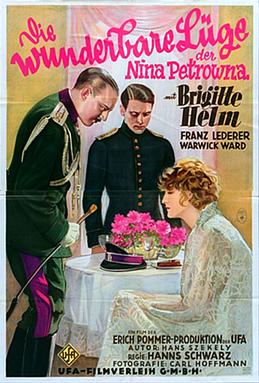
The Wonderful Lies of Nina Petrovna is a 1929 German sound drama film directed by Hanns Schwarz and starring Brigitte Helm, Francis Lederer and Warwick Ward. While there is no audible dialogue in the film, the soundtrack features a synchronized musical score with sound effects along with a theme song. It was the last big-budget film without dialogue released by the leading German studio Universum Film AG before the transition to sound began with Melody of the Heart. The film premiered on 15 April 1929 at the Ufa-Palast am Zoo in Berlin. It was amongst the most popular films released in Germany that year. A sound version was prepared for English speaking audiences. While the sound version has no audible dialog, it features a synchronized musical score with sound effects along with a theme song.
The House of Lies is a 1926 German silent drama film directed by Lupu Pick and starring Werner Krauss, Mary Johnson and Lucie Höflich. It is an adaptation of Ibsen's 1884 play The Wild Duck. The film's art direction was by Albin Grau. Pick also produced the film and was one of its co-writers.
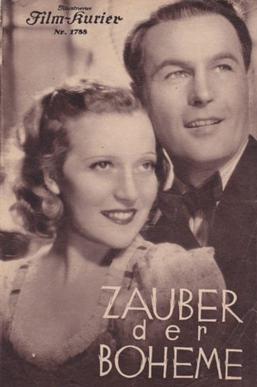
The Charm of La Bohème is a 1937 Austrian musical film directed by Géza von Bolváry and starring Jan Kiepura, Mártha Eggerth, and Paul Kemp. It follows the plot of Giacomo Puccini's 1896 opera La bohème. The film's sets were designed by Hans Ledersteger. The Berlin premiere took place at the Ufa-Palast am Zoo.

When Women Keep Silent is a 1937 German comedy film directed by Fritz Kirchhoff and starring Johannes Heesters, Hansi Knoteck and Friedrich Kramer. A newly married couple become involved in a series of marital differences, largely due to misunderstandings.

A Crazy Night is a 1927 German silent comedy film directed by Richard Oswald and starring Ossi Oswalda, Harry Liedtke and Henry Bender. It was shot at the EFA Studios in Berlin. The film's sets were designed by the art director Heinrich Richter.

My Heart Calls You is a 1934 German musical film directed by Carmine Gallone and starring Jan Kiepura, Mártha Eggerth and Paul Kemp. Separate English-language and French-language versions were made, both also directed by Gallone.
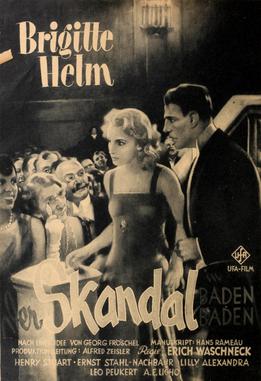
Scandal in Baden-Baden is a 1929 German silent drama film directed by Erich Waschneck and starring Brigitte Helm, Ernst Stahl-Nachbaur and Henry Stuart. It was shot at the Babelsberg Studios in Berlin and on location in Baden-Baden. The film's sets were designed by the art director Erich Czerwonski.

Inge and the Millions is a 1933 German comedy film directed by Erich Engel and starring Brigitte Helm, Carl Esmond, and Paul Wegener. Produced by UFA, it was shot at the Babelsberg Studios in Potsdam. The film's sets were designed by Otto Erdmann and Hans Sohnle. Location filming took place in Berlin and around Lake Constance.

Ship in Distress is a 1929 German silent drama film directed by Carmine Gallone and starring Liane Haid, Alfons Fryland, and Gina Manès.

A Rare Lover or Pikanterie is a 1950 West German romance film directed by Alfred Braun and starring Susanne von Almassy, Irene von Meyendorff and Curd Jürgens.

The Coral Princess is a 1937 German-Yugoslav comedy film directed by Victor Janson and starring Iván Petrovich, Hilde Sessak and Ita Rina.

In the Employ of the Secret Service is a 1931 German drama film directed by Gustav Ucicky and starring Brigitte Helm, Willy Fritsch, and Oskar Homolka. It concerns espionage between Germany and Russia during the First World War. It was made at the Babelsberg Studios in Berlin with sets designed by the art directors Robert Herlth and Walter Röhrig. Location shooting took place in Denmark.
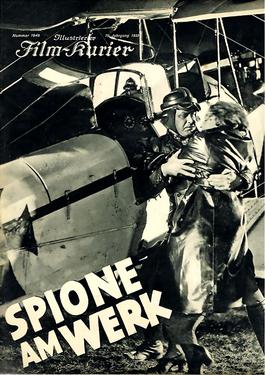
Spies at Work is a 1933 German thriller film directed by Gerhard Lamprecht and starring Karl Ludwig Diehl, Brigitte Helm, and Eduard von Winterstein. A spy film, it is set during the First World War conflict between Austria and Italy.
The Woman Without Nerves is a 1930 German adventure film directed by Willi Wolff and starring Ellen Richter, Walter Janssen and Anton Pointner. Interiors were filmed at the Staaken Studios in Berlin. Shot during 1929, it did not premiered until January 1930 at the Marmorhaus in Berlin.

The Island is a 1934 German thriller film directed by Hans Steinhoff and starring Brigitte Helm, Willy Fritsch and Hubert von Meyerinck. The film's sets were designed by the art directors Artur Günther and Benno von Arent. Location shooting took place on the coast of Dalmatia. It premiered at the Ufa-Palast am Zoo in Berlin in August 1934. A separate French version Vers l'abîme was also released.

The Happy Years of the Thorwalds is a 1962 West German drama film directed by Wolfgang Staudte and John Olden, starring Elisabeth Bergner, Hansjörg Felmy and Dietmar Schönherr. It is based on J.B. Priestley's 1937 play Time and the Conways, with the setting shifted from Britain to Germany. It portrays two family gatherings - the first in 1913 during the German Empire before the First World War and the second in 1932 in the dying days of the Weimar Republic before the Nazi takeover.
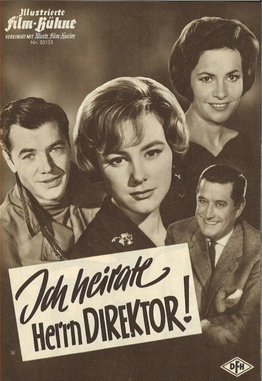
I'm Marrying the Director is a 1960 Austrian comedy film directed by Wolfgang Liebeneiner and starring Heidelinde Weis, Gerhard Riedmann and Hans Söhnker.

Ways to a Good Marriage is a 1933 German drama film directed by Adolf Trotz and starring Olga Chekhova, Alfred Abel and Hilde Hildebrand. It was shot at the EFA Studios in Halensee in Berlin. The film's sets were designed by the art directors Heinz Fenchel and Botho Hoefer. The film was based on the ideas of the sexologist Theodore H. Van de Velde and was in the tradition of the enlightenment films of the Weimar Republic. Although his work had already been forbidden by the new Nazi regime, it was not formally banned until 1937 despite protests by Nazi students in Kiel who were successful in having the film pulled from cinemas there.

















